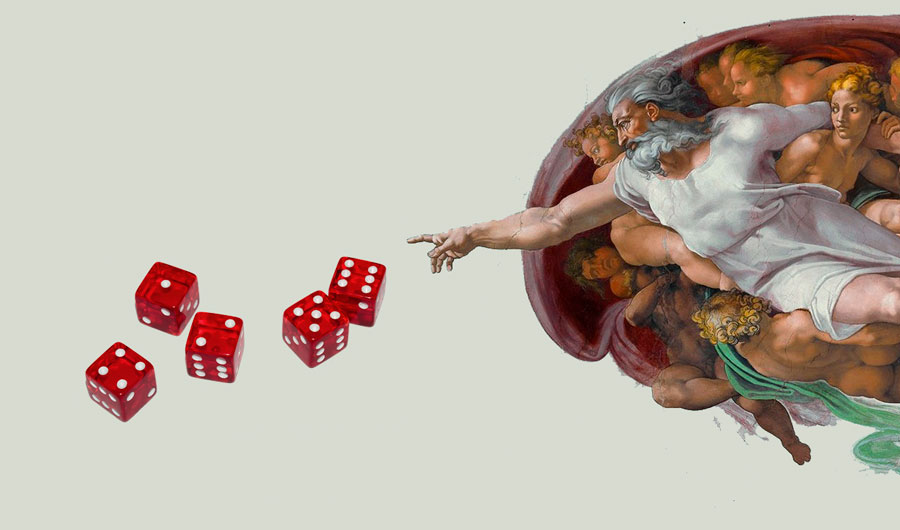Randomness from a Machine

Composite image by Yuen Yiu, Staff Writer, prepared from Creation of Adam by Michelangelo (Public Domain) and dice photo by PierreSelim (CC BY 3.0).
Copyright American Institute of Physics (reprinting information)
(Inside Science) -- Researchers in China have developed a way to improve the reliability and security of machines that use quantum phenomena to generate random numbers. This is crucial to the development of other related technologies, such as secure quantum communication and computer simulations used in weather forecasts.
As high profile hackings steadily increase (causing major security breaches and a good deal of embarrassment), governments and corporations have shown immense interest in improving the way they encrypt messages. China launched the first ever quantum communication satellite earlier this year, hoping to test out new techniques for more secure telecommunication. Now, some of the scientists from that very same project have tapped into quantum weirdness for another application -- to generate random numbers.
A machine does not play dice
Quick! Pick a random number between 1 and 10. While this may seem to be an easy task for us, it is not that straightforward for computers. A regular computer, like a machine, is deterministic by design, meaning that the same input always produces the same output. In order to generate random numbers, it needs a random input from outside -- such as the timestamp when a human user hits the "Enter" button -- to act as a "seed". Then, with clever programming, the computer can generate a cascade of pseudorandom numbers, but it risks long term repetition if the system somehow loops back to its initial condition.
"The output of these pseudorandom number generators is in principle predictable," said Xiongfeng Ma, an information scientist from Beijing's Tsinghua University, who was a part of the Chinese group. "They are good enough for most applications like simulations, but not for high security crypto systems."
In order to produce numbers that are truly random, scientists have looked into the quantum world for answers.
The probabilistic world of quantum
Quantum phenomena are fundamentally probabilistic. For example, there is a 50-50 chance that a single carbon-14 atom will decay into nitrogen-14 within 5,730 years. It may happen, it may not, and nobody can tell until it happens. Austrian physicist Erwin Schrödinger once explained this concept with a famous analogy involving a cat that was simultaneously dead and alive. So, as much as Einstein himself hated to admit it, God does play dice.
Ever since scientists discovered quantum phenomena in the 1920s, they have found many applications for these discoveries -- from laser pointers to computers chips to MRI machines.
Earlier in August, China launched the first ever quantum communication satellite. According to Ma, all of the three main tasks to be carried out by the satellite rely on quantum random number generation. Although they have not yet implemented their latest research in the already launched satellite, he said that they hope to do so for future systems.
Checking on random
Quantum random number generators have been around for decades, but it is not until more recently that they have become commercially available. However, it is still a constantly evolving technology. According to Ma, the technology is still being improved in three aspects -- security, efficiency and practicability.
"As researchers, we keep pushing the security limits," he said.
Instead of churning out pseudorandom numbers with deterministic programming, quantum random number generators directly measure fundamentally random quantum phenomena, and then translate them into random numbers. But before all this can be done, one need to first correctly characterize the source that produces these quantum phenomena. For example, if you have chosen a lump of decaying carbon-14 as your source, you would need to at least know the mass and purity of the lump that is being measured.
"Even if you have a very good [quantum] random number generator, there will still be some residual bias, so there needs to be a way to test and clean the data," said Juan Carlos Garcia-Escartin, a telecommunication scientist from University of Valladolid in Spain.
This need for post-measurement processing exposes the system to potential hacking. Ma and his team have developed a way to detect if a system is compromised. The basic concept is pretty simple -- they use the random source to trigger random testing of the data, kind of like pop-quizzes for a class of students.
This involves repeatedly shuffling and dividing the output numbers into four random groups, then testing them and crosschecking their results for anomalies. If the numbers are truly random and unbiased, any manipulation by an outsider would show up in these tests. Once this testing method is implemented, then even an untrusted quantum random number generator can still be used without the fear of compromising the level of randomness generated.
The researchers' paper has been accepted for publication in the journal Physical Review A.

